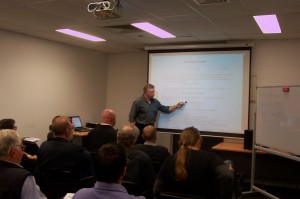On Monday April 14th, 26 AES Melbourne Section members and guests gathered at the Australian College of the Arts in South Melbourne to hear Bohdan Raczynski of Bodzio Software describe the processes involved in implementing a phase linear monitor loudspeaker system with flat axial response using his company’s Ultimate Equalizer software.
Bohdan first touched lightly on passive crossover and corrective circuit design; the kind of typical CAD tools used in their design, and enumerated some limitations of this approach. He concluded that designing passive crossovers involves a bunch of compromises, and asked (rhetorically) “Can we do better?” He also noted that certain topologies can only be implemented using DSP.
Bohdan then referenced Hendrik Bode’s book “Network Analysis and Feedback Amplifier Design” (first published 1945), and outlined how, after reading this book about 15 years ago realized the importance of frequency-phase relationship. He then referenced the work of David Hilbert, and demonstrated applying these techniques over the desired frequency range produced the required information for processing in both the amplitude and time domain. He coined the term Hilbert Bode Transform (HBT) for his algorithm referencing the work of Dr Bhttps://s3-ap-southeast-2.amazonaws.com/aesmel/Bohdan_14Apr2014_final.mp3ode and mathematician David Hilbert.
He then demonstrated how measured SPL curves with phase information for various loudspeakers were transformed using his HBT algorithm for processing with his Ultimate Equalizer software.
Using a computer with soundcard and UE software he demonstrated how after applying the Hilbert Bode (HBT) transform he could apply amplitude correction by inversion and showed the result of this correction to a an applied square wave https://s3-ap-southeast-2.amazonaws.com/aesmel/Dr+Rodney+Staples+Aug+2013-+Microphones.mp3signal. He then demonstrated that applying HBT phase correction i.e. apply a phase reversal of the phase response resulted in a phase linear response, resulting in a very accurate output signal. Oscilloscope displays revealed an acoustic output out to a square wave input signal which was extremely close approximation of the input signal.
A real-life loudspeaker and loudspeaker system examples were then presented, showing the HBT linearized system to be magnitude equalized with linear phase. Also off-axis response options were discussed.
A causality of DSP processing is latency, the special case of an audio-visual system where latency is of concern (lip-sync issues) was covered, where the delay associated with DSP processing can impose unacceptable latency, hence typical incurred latency with this EQ approach may be an important consideration.
Bohdan then moved on to the room equalization application, covering the basics of when and where the Ultimate Equalizer HBT DSP can be employed to tame the worst of a listening room’s errors.
He then showed diagrams of hardware systems implementing a 24bit/96kHz system in a range of combinations from 2 channel stereo to a 7.4 surround system (with Binaural Bass Management and Controlled Acoustic Bass System), based on a Delta 1010 and/or Lynx soundcard in a host windows computer (which is also running the media player software) and MiniDSP’s PWR-ICE125 digital power amplifiers.
The presentation was followed by a lively Q&A session, and the range and depth of the questions demonstrated the audience’s keen interest in this new approach to a complex issue.
-Resources-
A PDF document containing the Powerpoint slides is available for viewing or downloading here
-and-
An audio recording of Bohdan’s presentation is available for listening or downloading here
Special thanks to Michail Barabasz for his contributions to this meeting report.

